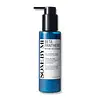What's inside
What's inside
 Key Ingredients
Key Ingredients

 Benefits
Benefits

 Concerns
Concerns

 Ingredients Side-by-side
Ingredients Side-by-side

Water
Skin ConditioningSodium Cocoyl Isethionate
CleansingSodium Methyl Cocoyl Taurate
CleansingGlycerin
HumectantDipropylene Glycol
HumectantCoco-Betaine
CleansingLauryl Hydroxysultaine
CleansingPanthenol
Skin Conditioning1,2-Hexanediol
Skin ConditioningGlyceryl Stearate
EmollientSodium Chloride
MaskingPropylene Glycol Laurate
Skin ConditioningPolyglyceryl-3 Methylglucose Distearate
EmulsifyingGlycol Distearate
EmollientMusa Sapientum Fruit Extract
Skin ConditioningRosa Damascena Flower Water
MaskingPolyquaternium-67
Pyrus Communis Fruit Extract
Skin ConditioningPrunus Domestica Fruit Extract
MoisturisingCitric Acid
BufferingEthylhexylglycerin
Skin ConditioningCucumis Melo Fruit Extract
Skin ConditioningDisodium EDTA
Hedera Helix Leaf/Stem Extract
AntimicrobialGluconolactone
Skin ConditioningSea Water
HumectantPropanediol
SolventSodium Acetate
BufferingArginine
MaskingHydrogenated Lecithin
EmulsifyingSorbitan Olivate
EmulsifyingCetearyl Olivate
Beta-Sitosterol
Emulsion StabilisingLactococcus Ferment Lysate
Skin ConditioningBifida Ferment Lysate
Skin ConditioningLactobacillus Ferment Lysate
Skin ConditioningPhytosterols
Skin ConditioningTocopherol
AntioxidantGlycine
BufferingSerine
MaskingGlutamic Acid
HumectantAspartic Acid
MaskingLeucine
Skin ConditioningAlanine
MaskingLysine
Skin ConditioningTyrosine
MaskingPhenylalanine
MaskingValine
MaskingThreonine
Proline
Skin ConditioningIsoleucine
Skin ConditioningHistidine
HumectantMethionine
Skin ConditioningCysteine
AntioxidantWater, Sodium Cocoyl Isethionate, Sodium Methyl Cocoyl Taurate, Glycerin, Dipropylene Glycol, Coco-Betaine, Lauryl Hydroxysultaine, Panthenol, 1,2-Hexanediol, Glyceryl Stearate, Sodium Chloride, Propylene Glycol Laurate, Polyglyceryl-3 Methylglucose Distearate, Glycol Distearate, Musa Sapientum Fruit Extract, Rosa Damascena Flower Water, Polyquaternium-67, Pyrus Communis Fruit Extract, Prunus Domestica Fruit Extract, Citric Acid, Ethylhexylglycerin, Cucumis Melo Fruit Extract, Disodium EDTA, Hedera Helix Leaf/Stem Extract, Gluconolactone, Sea Water, Propanediol, Sodium Acetate, Arginine, Hydrogenated Lecithin, Sorbitan Olivate, Cetearyl Olivate, Beta-Sitosterol, Lactococcus Ferment Lysate, Bifida Ferment Lysate, Lactobacillus Ferment Lysate, Phytosterols, Tocopherol, Glycine, Serine, Glutamic Acid, Aspartic Acid, Leucine, Alanine, Lysine, Tyrosine, Phenylalanine, Valine, Threonine, Proline, Isoleucine, Histidine, Methionine, Cysteine
Honey
HumectantRoyal Jelly Extract
Skin ConditioningCeramide NP
Skin ConditioningVitis Vinifera Seed Oil
EmollientSaponaria Officinalis Leaf Extract
AntimicrobialQuillaja Saponaria Bark Extract
CleansingSapindus Mukorossi Fruit Extract
Skin ConditioningOlea Europaea Leaf Extract
PerfumingOenothera Biennis Oil
EmollientLactobacillus/Soybean Ferment Extract
Skin ConditioningPortulaca Oleracea Extract
Skin ConditioningCinnamomum Cassia Bark Extract
MaskingScutellaria Baicalensis Root Extract
AstringentOriganum Vulgare Leaf Extract
Skin ConditioningChamaecyparis Obtusa Leaf Extract
Skin ConditioningSalix Alba Bark Extract
AstringentGlycolipids
Skin ConditioningPhytosphingosine
Skin ConditioningSodium Cocoyl Glycinate
CleansingSodium Cocoyl Apple Amino Acids
Skin ConditioningPotassium Cocoyl Hydrolyzed Oat Protein
Skin ConditioningBabassuamidopropyl Betaine
CleansingCoco-Glucoside
CleansingPotassium Stearate
CleansingPotassium Myristate
EmulsifyingTromethamine
BufferingSodium Surfactin
CleansingGlyceryl Laurate
EmollientHydrogenated Lecithin
EmulsifyingErythritol
HumectantCaprylic/Capric Triglyceride
MaskingButylene Glycol
HumectantDipropylene Glycol
HumectantC12-15 Alkyl Benzoate
AntimicrobialCaprylyl Glycol
EmollientHexylene Glycol
EmulsifyingEthylhexylglycerin
Skin ConditioningGlyceryl Caprylate
EmollientSodium Benzoate
MaskingPentylene Glycol
Skin ConditioningCI 17200
Cosmetic ColorantCI 19140
Cosmetic ColorantTetrasodium Glutamate Diacetate
Disodium EDTA
Parfum
MaskingHoney, Royal Jelly Extract, Ceramide NP, Vitis Vinifera Seed Oil, Saponaria Officinalis Leaf Extract, Quillaja Saponaria Bark Extract, Sapindus Mukorossi Fruit Extract, Olea Europaea Leaf Extract, Oenothera Biennis Oil, Lactobacillus/Soybean Ferment Extract, Portulaca Oleracea Extract, Cinnamomum Cassia Bark Extract, Scutellaria Baicalensis Root Extract, Origanum Vulgare Leaf Extract, Chamaecyparis Obtusa Leaf Extract, Salix Alba Bark Extract, Glycolipids, Phytosphingosine, Sodium Cocoyl Glycinate, Sodium Cocoyl Apple Amino Acids, Potassium Cocoyl Hydrolyzed Oat Protein, Babassuamidopropyl Betaine, Coco-Glucoside, Potassium Stearate, Potassium Myristate, Tromethamine, Sodium Surfactin, Glyceryl Laurate, Hydrogenated Lecithin, Erythritol, Caprylic/Capric Triglyceride, Butylene Glycol, Dipropylene Glycol, C12-15 Alkyl Benzoate, Caprylyl Glycol, Hexylene Glycol, Ethylhexylglycerin, Glyceryl Caprylate, Sodium Benzoate, Pentylene Glycol, CI 17200, CI 19140, Tetrasodium Glutamate Diacetate, Disodium EDTA, Parfum
 Reviews
Reviews

Ingredients Explained
These ingredients are found in both products.
Ingredients higher up in an ingredient list are typically present in a larger amount.
Dipropylene Glycol is a synthetically created humectant, stabilizer, and solvent.
This ingredient helps:
Dipropylene glycol is technically an alcohol, but it belongs to the glycol family (often considered part of the ‘good’ alcohols). This means it is hydrating and gentle on skin unlike drying solvent alcohols like denatured alcohol.
As a masking agent, Dipropylene Glycol can be used to cover the smell of other ingredients. However, it does not have a scent.
Studies show Dipropylene Glycol is considered safe to use in skincare.
Learn more about Dipropylene GlycolDisodium EDTA plays a role in making products more stable by aiding other preservatives.
It is a chelating agent, meaning it neutralizes metal ions that may be found in a product.
Disodium EDTA is a salt of edetic acid and is found to be safe in cosmetic ingredients.
Learn more about Disodium EDTAEthylhexylglycerin (we can't pronounce this either) is commonly used as a preservative and skin softener. It is derived from glyceryl.
You might see Ethylhexylglycerin often paired with other preservatives such as phenoxyethanol. Ethylhexylglycerin has been found to increase the effectiveness of these other preservatives.
Hydrogenated Lecithin is created from the hydrogenation of lecithin (a group of phospholipids). Hydrogenation is a chemical reaction between hydrogen and another element.
This ingredient is an emollient and emulsifier. As an emollient, it helps soften skin by trapping moisture within. As an emulsifier, it prevents oil and water ingredients from separating.